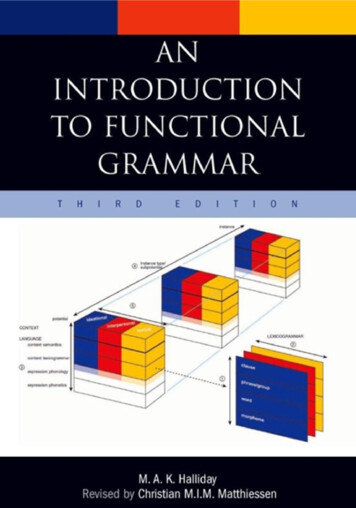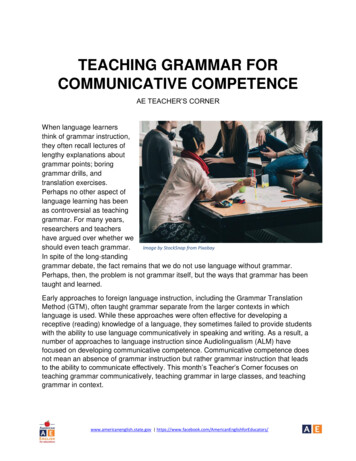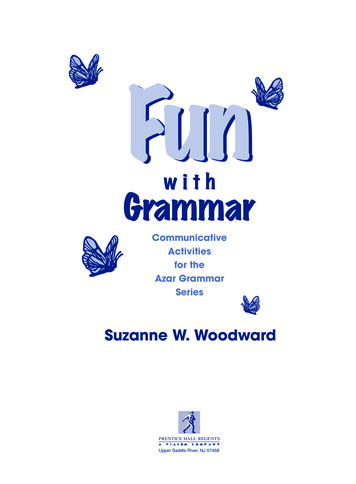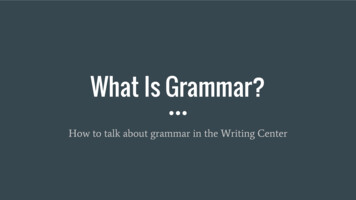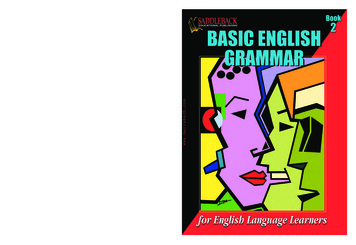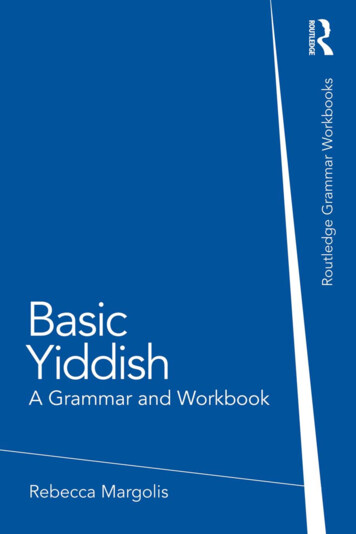
Transcription
BASIC YIDDISH: A GRAMMARAND WORKBOOKBasic Yiddish: A Grammar and Workbook comprises an accessiblereference grammar with related exercises in a single volume.The workbook is structured around 25 short units, each presenting relevantgrammar points which are explained using multiple examples in jargonfree language.Basic Yiddish is suitable for both class use as well as independent study.Key features include: a clear, accessible formatmany useful language examplesjargon-free explanations of grammarabundant exercises with a full answer keyClearly presented and user-friendly, Basic Yiddish provides readers withthe essential tools to express themselves in a wide variety of situations,making it an ideal grammar reference and practice resource for bothbeginners and students with some knowledge of the language.Rebecca Margolis is Associate Professor at the University of Ottawa,Canada.
Other titles available in the Grammar Workbooks series are:Basic CantoneseIntermediate CantoneseBasic ChineseIntermediate ChineseBasic GermanIntermediate GermanBasic ItalianBasic IrishIntermediate IrishBasic JapaneseIntermediate JapaneseBasic KoreanIntermediate KoreanBasic PolishIntermediate PolishBasic RussianIntermediate RussianBasic SpanishIntermediate SpanishBasic WelshIntermediate Welsh
BASIC YIDDISH:A GRAMMAR ANDWORKBOOKRebecca Margolis
First published 2011by Routledge2 Park Square, Milton Park, Abingdon, Oxon OX14 4RNSimultaneously published in the USA and Canadaby Routledge711 Third Avenue, New York, NY 10017Routledge is an imprint of the Taylor & Francis Group, an informa business 2011 Rebecca MargolisThe right of Rebecca Margolis to be identified as author of this work has beenasserted by her in accordance with sections 77 and 78 of the Copyright,Designs and Patents Act 1988.All rights reserved. No part of this book may be reprinted or reproducedor utilized in any form or by any electronic, mechanical, or other means,now known or hereafter invented, including photocopying and recording,or in any information storage or retrieval system, without permission inwriting from the publishers.Trademark notice: Product or corporate names may be trademarksor registered trademarks, and are used only for identification andexplanation without intent to infringe.British Library Cataloguing in Publication DataA catalogue record for this book is available from the British LibraryLibrary of Congress Cataloging in Publication DataA catalog record for this book has been requestedISBN: 978-0-415-55521-0 (hbk)ISBN: 978-0-415-55522-7 (pbk)ISBN: 978-0-203-80887-0 (ebk)Typeset in Times Ten and New Peninim MTby Graphicraft Limited, Hong Kong
CONTENTSviiPreface1 Introduction to nouns, articles, attributive adjectives,noun phrases, the nominative case, pronouns12 Introduction to verbs, regular verbs in the presentindicative tense113 Irregular verb to be זײַן , the predicative (predicate nouns,pronouns and adjectives)164 Adverbs and adjective quantifiers215 Numbers256 Possessive pronouns297 Negation338 Yiddish word order 1: verb position, direct questions,the second person conjugation of the imperative mood(direct commands)389 Yiddish word order 2: conjunctions, relative pronouns,relative clauses, consecutive word order (“so”)4610 Irregular infinitives: to have האָבן , and others5111 The accusative case, declension of proper names5412 Prepositions, adverbs designating place6013 Indirect object, the dative case, declension of nouns,the dative as possessive case6514 Declension of pronouns7415 The pronoun זיך 78v
Contents16 Yiddish word order 3: verbs with more than one part:the periphrastic verb to like, love ליב האָבן 8017 Mood: modal verbs, conjugations of the first andthird person of the imperative mood, the subjunctive mood8618 The future tense9119 The past tense9420 Verbs with prefixes: separable prefix verbs (complementedverbs), inseparable prefix verbs21 Aspect: repeated action in the pastconstructions11022 The conditional mood11323 The participle and suffixes on nouns, adjectives and verbs11724 Demonstrative pronouns12225 Comparative and superlative adjectives127Glossary of working vocabularyKey to exercisesIndexvi פֿלעגן , aspectual verbal101131135164
PREFACEThis text offers a basic introduction to Standard Yiddish (klal-yidish)grammar along with practice exercises. Its aim is to provide an accessiblesurvey of Yiddish grammatical structures for the beginner as well as themore advanced Yiddish learner. It assumes previous familiarity with theYiddish alphabet and the ability to read printed Yiddish. This book isintended to supplement other textbooks and learning materials and/orserve as grammar reference and practice for all speakers of Yiddish. Eachunit contains an overview of grammatical forms with explanations andtables as well as examples. Note: Tables are read from right to left. Itintroduces a small working vocabulary for the purposes of examples andpractice in exercises, with Yiddish vocabulary words listed in alphabeticalorder in the glossary at the back. Chapters conclude with exercises designedto allow learners to practice using the new grammatical form: formidentification, matching, fill-in-the-blank, manipulation of a grammaticalform, translation into English, translation into Yiddish, and so on. A fullanswer key to all exercises is provided at the end of the text.Preliminary notes1. TerminologyYiddish is an inflected language. That is, words change forms to expressgrammatical categories of nouns (gender, number, case) as well as verbalforms (person, tense, mood, and aspect). Conjugation refers to the inflectionof verbs; declension refers to the inflection of nouns, adjectives and pronouns.Stress refers to which syllable of a word receives the emphasis. In Yiddish,most words have penultimate stress: the second-to-last syllable is stressed.Example: mother mame מאַמע . Suffixes on words do not count as syllables.2. Yiddish variationThere is variation in Yiddish due to the language’s many dialects. Further,there is no universally agreed-upon set of rules regarding Yiddish orthography.vii
The system employed in this text is the most commonly taught and published form of the language in academic and secular contexts: StandardYiddish (klal-yidish), devised by the YIVO Institute for Jewish Research.However, today the majority of Yiddish publications are produced inreligious communities which use a variety of spelling systems.Preface3. Loshn-koydesh קודש - לשון Loshn-koydesh refers to the pre-Modern Hebrew-Aramaic component ofYiddish, which constitutes elements that stem from Biblical, Talmudic andother rabbinic texts. These words are fully integrated into Yiddish (theway that elements of Greek origin are integrated into English), but, unlikethe rest of Standard Yiddish, they are not spelled phonetically. That is,they are not spelled the way they are pronounced.Example: wedding (pronounced khasene) חתונה .The proportion of loshn-koydesh words in Yiddish ranges from text totext. For the sake of reading ease, this text uses a minimal number ofwords of loshn-koydesh derivation in the vocabulary lists and examples.Selected bibliography of books for reference andfurther studyGrammar textbooksEstraikh, Gennady, Intensive Yiddish (Oxford: Oksforder Yidish Press, 1996).Schaechter, Mordkhe, Yiddish II: An Intermediate and Advanced Textbook(New York: League for Yiddish, 1986, 1993, 1995, 2003).Weinreich, Uriel, College Yiddish: An Introduction to the Yiddish Languageand to Jewish Life and Culture (New York: YIVO Institute for JewishResearch, 1949). Several subsequent editions.Zucker, Sheva, Yiddish: An Introduction to the Language, Literature andCulture, Volume 1 (Hoboken, NJ: KTAV Publishing House, 1994).——, Yiddish: An Introduction to the Language, Literature and Culture,Volume 2 (New York: Workmen’s Circle, 2002).Yiddish reference grammarsviiiBirnbaum, Salomo A., Yiddish: A Survey and a Grammar (Toronto:University of Toronto Press, 1979).Jacobs, Neil G., Yiddish: A Linguistic Introduction (Cambridge, UK:Cambridge University Press, 2005).Katz, Dovid, Grammar of the Yiddish Language (London, UK: GeraldDuckworth & Co Ltd, 1987).
Mark, Yudl, Gramatik fun der yidisher klal-shprakh [Grammar of StandardYiddish] (New York: Congress for Jewish Culture, 1978).Schaechter, Mordkhe, Takones fun yidishn oysleyg [The StandardizedYiddish Orthography]; Fun folkshprakh tsu kulturshprakh [The Historyof the Standardized Yiddish Spelling] (New York: League for Yiddish,YIVO Institute for Jewish Research, 1999).Zaretski, Ayzik, Praktishe yidishe gramatik [Practical Yiddish Grammar](Moscow: Farlag “shul un bukh”, 1926, 1927, 1929).PrefaceDictionariesHarkavy, Alexander. Yiddish-English-Hebrew Dictionary (New York:Hebrew Publishing Company, 1910). Numerous subsequent editions.Joffe, Yudah A., and Yudl Mark, eds. Groyser FerEerbukh fun der yidishershprakh, 4 volumes (New York: aomieee farn groysn fereerbukh funder yidisher shprakh, 1961–1980). Only the letter alef has been published.Niborski, Yitskhak. Verterbukh fun loshn-koydesh-shtamike verter/Dictionnaire des mots d’origine hébraïque et araméenne en usage dansla langue yiddish (Paris: Medem Bibliotek, 1997).Kerner, Samuel and Bernard Vaisbrot. Frantseyzish/yidish-verterbukh/Dictionnaire Français-Yiddish (Paris: Bibliothèque Medem, 2000).Niborski, Yitskhok and Bernard Vaisbrot. Yidish-frantseyzish verterbukh/Dictionnaire Yiddish-Français (Paris: Bibliothèque Medem, 2002).Weinreich, Uriel. English-Yiddish/Yiddish-English Dictionary (New York:YIVO Institute for Jewish Research, Schocken Books, 1968). Severalsubsequent editions.ix
UNIT 1Introduction to nouns, articles,attributive adjectives, noun phrases,the nominative case, pronounsNounsA noun is a part of speech that refers to a person, other living thing,object, place or abstract idea. Examples of nouns include: mother, class,city, and greatness.All Yiddish nouns possess three characteristics known as (1) gender,(2) number, and (3) case.1. GenderGender refers to three fixed grammatical categories into which all nounsfall: masculine, feminine, and neuter. In Yiddish, the Yiddish word forevery noun has a fixed gender: e.g. “man” is masculine in gender, as is“class.” All nouns belong to one of these three grammatical categories,including all animate, inanimate objects and abstract concepts. Gendermust be learned with each noun.A word of caution regarding the concept of “gender”As a rule, nouns that are semantically masculine (i.e. they refer to nounsthat are biologically male) are masculine in gender (e.g. brother, father),and semantically female nouns are female (e.g. sister, mother). Small thingsare often neuter (e.g. baby, puppy).However, gender in Yiddish functions simply as a way of categorizingnouns into grammatical categories: a class or a park is not “male” because itis masculine; masculine simply tells us what the forms of the definite article(“the”) and adjective (example: good) that form a noun phrase with “class”or “park” will take. In Yiddish, the words “the” and “good” in the phrases“the good class” or “the good park” will have the same form as “the goodperson” (also masculine) but different forms from the noun phrases “thegood mother” or “the good city” (both feminine) or “the good book”1
1Introductionto nouns,articles,attributiveadjectives,noun phrases,the nominativecase,pronouns(neuter). There is no reliable, universal way for most nouns to tell whetherthey will be masculine, feminine or neuter.In sum, masculine gender does not refer to “maleness” and feminine gender does not refer to “femaleness.” Rather, gender is one ofthree grammatical categories that determine the form a given nounphrase (definite article and/or adjective noun) will take in a Yiddishsentence.Vocabulary: examples of nouns and their gendersTranslationperson, human beingmotherbookExample of noun מענטש מאַמע בוך GendermasculinefeminineneuterNote the differences in the form of the word “the” and the endings onthe adjective “good” in these examples:the good personthe good motherthe good book דער גוטער מענטש די גוטע מאַמע דאָס גוטע בוך Yiddish compound nouns (nouns made up of a noun fused toanother noun/an adjective/a verbal base), take on the gender of the secondnoun.Example:the homework די היימאַרבעט 2. Number2Number refers to singular (one) or plural (more than one). Yiddishnouns as well as their definite articles and adjectives inflect in theplural.Yiddish has several ways of forming plurals. These can include endingssuch as ס or ן , changes in the word itself, and other variations. These donot necessarily correspond to the form of the singular or the gender ofthe noun and should be learned.
Examples of nouns and their plural forms:TranslationArticlesPlural form of nounSingular form of noun מענטשן מאַמעס ביכער מענטש מאַמע בוך peoplemothersbooks3. CaseThe case of a noun indicates its grammatical function relative to the verb:Is it doing the action? Is it receiving the action? Is it next to/under/aboutsomething? Cases embody a system of inflection to indicate these functions. Yiddish has three cases: nominative, accusative, and dative. Thenominative case will be discussed more fully later in this unit; the accusative and dative cases will be presented in separate units.Cases are also called “declensions.” When the forms of definite articles(“the”), adjectives, and personal pronouns change forms according togender, number and case, this is called declining.ArticlesYiddish articles appear in two forms: indefinite and definite.1. The indefinite article (“a”)The indefinite article (“a”) refers to a generic, non-specific noun or nouns(a person or people). It means “any” member of the category of this noun.In the singular it always appears as א ַ or ( אַן the form of ַא before a vowel):it is never inflected (does not change form according to gender and case).The plural indefinite is formed without an article, as in English: e.g.a person (singular); people (plural). It is not inflected.Examples in the singular form:Translationa (any) persona (any) mothera (any) bookDefinite article-noun phraseIndefinite article “a” ַא מענטש ַא מאַמע ַא בוך ַא 3
Examples in the plural form:1Introductionto nouns,articles,attributiveadjectives,noun phrases,the nominativecase,pronounsTranslationIndefinite article-noun phrase מענטשן מאַמעס ביכער (any) people(any) mothers(any) booksIndefinite article “a”none2. The definite article “the”The definite article “the” refers to a specific noun or nouns (the person,this person, the people, these people). Definite articles decline: their formsare determined by the gender, number and case of the noun.As discussed in Unit 24, the Yiddish definite article can also function as demonstrative adjectives with the meaning of an implicit “this”.Examples in the singular form:TranslationDefinite article-noun phraseDefinite article “the” דער מענטש די מאַמע דאָס בוך דער די דאָס Definite article-noun phraseDefinite article “the” די מענטשן די מאַמעס די ביכער די the (specific) personthe (specific) motherthe (specific) bookExamples in the plural form:Translationthe (specific) peoplethe (specific) mothersthe (specific) booksAttributive adjectivesAn adjective is a part of speech that describes a noun, such as “good” or“small.” In Yiddish, the shortest form of an adjective is called the baseform.4
Vocabulary: examples of adjectivesTranslationNoun phrasesAdjective גוט גרויס פֿריילעך קליין שיין goodgreat, largehappysmallnice, attractiveAn adjective that describes a noun is known as an attributive (descriptive)adjective. Its position follows the article and precedes the noun it modifies.In its form, it shares the same gender, number and case as the noun, andinflects accordingly. Inflection is indicated by special endings on the baseforms of the adjectives.Attributive adjective base endingsThis chart offers a comparison of the masculine, feminine and neuterdefinite singular forms as well as the plural form in the nominative case(see below). A sample noun is provided as an example of each.Translationgood persongood mothergood bookgood peoplegood mothersgood booksExamples:adjective-noun גוטער מענטש גוטע מאַמע גוטע בוך גוטע מענטשן גוטע מאַמעס גוטע ביכער Example:adjectivebase form גוט Ending onadjectivebase –ער –ע –ע –ע Gendermasculinefeminineneuterplural(all genders)Noun phrasesNouns often appear in noun phrases together with an article (“a” or “the”)and an attributive adjective.5
1Introductionto nouns,articles,attributiveadjectives,noun phrases,the nominativecase,pronounsIn a Yiddish noun phrase, the article, adjective and noun must always“agree” (match) in gender, number and case. That is, if a noun is masculine in gender, singular in number, and nominative in case, its article andadjective must appear in the corresponding forms.The forms for articles and adjectives follow set patterns that will bepresented in this text, with the forms for the word “the” and the endingson the adjective changing depending on the gender, number and case ofthe noun they are modifying.Important things to note:1. Adjectives decline (take adjective endings) only when they precedea noun in a noun phrase.2. With a very few exceptions, nouns only decline in the plural.The nominative caseThe nominative case refers to the noun (and its article/adjective), that isthe “doer” of the verb.For example: “The nice child reads a book under the green tree.”Who is the “doer” of the verb, i.e. who is doing the action of reading?The child.In the above sample sentence, the Yiddish noun phrase “The nice child” isin the nominative case, with the article and adjective agreeing with “child.”Nominative caseTranslationSample nounphrasethe good person דער גוטער מענטש ַא גוטער מענטש די גוטע מאַמע ַא גוטע מאַמע דאָס גוטע בוך ַא גוט בוך a good personthe good mothera good motherthe good booka good book6Attributive Articleadjectiveending onbase –ער –ער –ע –ע –ע definiteSample Gendernounnumber דער indefinitedefinitethe ַא דאָס no ending indefinitemasculinesingular מאַמע femininesingular ַא די indefinite מענטש ַא בוך neutersingular
TranslationSample nounphrasethe good peoplethe good mothersthe good books די גוטע מענטשן די גוטע מאַמעס די גוטע ביכער גוטע מענטשן גוטע מאַמעס גוטע ביכער good peoplegood mothersgood booksAttributive Articleadjectiveending onbase –ע –ע theSample GendernounnumberPronouns די indefinite – מענטשן מאַמעס ביכער plural allgendersThe noun phrase “ ”די גוט מענטש is grammatically incorrect in Yiddish,because the forms of the article and adjective do not agree with the nounin gender, number and case. Because the word מענטש is masculineand singular, the correct form of the phrase in the nominative case is“ ”דער גוטער מענטש .Note: Yiddish noun phrases in the neuter indefinite as well as all pluralforms retain the same endings in all cases.Notes on article-adjective-noun agreement:If an indefinite article א ַ or אַן refers to masculine, feminine or pluralnouns, the adjective takes the same form as it would with the definitearticle. This is true in all cases. דער גוטער מענטש – ַא גוטער מענטש די גוטע מאַמע – ַא גוטע מאַמע די גוטע ביכער – גוטע ביכער However, if an indefinite article refers to a neuter noun, then its adjectiveremains in its base form. This is true for all cases. דאָס גוטע בוך – ַא גוט בוך PronounsPronouns stand in for nouns. In Yiddish, pronouns change their form toindicate number, gender, and case as well as person: first person (I, we),second person (you) or third person (he, she, it, one, they). There are afew pronouns that never decline, such as what וואָס .7
1Introductionto nouns,articles,attributiveadjectives,noun phrases,the nominativecase,pronounsA personal pronoun replaces a specific person or thing. A personalpronoun will share the same person, number, gender and case as the nounit is replacing.For example: The mother is sleeping. She is sleeping.Here are the pronouns in the nominative case, which indicates that thepersonal pronoun is “the doer” the verb (i.e. is the subject of the verb;for example, I write).Personal pronouns in the nominative casePersonal pronoun איך דו ער זי (also ’ ס / עס )סע z(also ’ מ / מען )מע z מיר איר זיי Person, number, translationFirst person singular: ISecond person singular: you/thouThe familiar, informal form akin to tu in FrenchThird person singular masculine: heThird person singular feminine: sheThird person singular neuter: itCan also function as a placeholder in a sentencewithout a logical subjectExample: It is raining א רעגן ַ עס גייט Third person singular impersonal: one (they)A way of forming the passive in Yiddish:Example: One knows, it is known מען ווייס First person plural: weSecond person plural: youAlso used for the formal form akin to vous in FrenchThird person plural: theyExercise 1.1For each noun on the list below, identify the gender, number and case.When in doubt, check the vocabulary list above. Note: All nouns in thisunit’s exercises are nominative.8
Example:Exercise 1.3gender: feminine; number: singular; case: nominative מאַמע בוך מענטשן מאַמעס ביכער מענטש .1.2.3.4.5Exercise 1.2Write in the correct matching form of the definite (“the”) and indefinite(“a”) article and adjective. Refer to exercise 1 above and the nominativecase chart.Example: ד גוט מענטש \ גוט מענטש masculine, singular, nominative מענטש דער גוטער מענטש \ ַא גוטער מענטש ד גוט בוך \ גוט בוך ד גוט ביכער \ גוט ביכער ד גוט מאַמע \ גוט מאַמע ד גוט מאַמעס \ גוט מאַמעס ד גוט מענטשן \ גוט מענטשן .1.2.3.4.5Exercise 1.3Replace each noun or noun phrase with the corresponding pronoun.Note: The pronoun should match the original noun in gender, number,and case.If the noun is:The pronoun to replace it is:masculine singular ער feminine singular זי עס זיי neuter singularall plurals9
Example:1Introductionto nouns,articles,attributiveadjectives,noun phrases,the nominativecase,pronounsmasculine, singular, nominative ַא קליינער מענטש The pronoun is also third person, masculine, singular, nominative ער די מאַמעס דאָס גרויסע בוך שיינע מענטשן די ביכער ַא פֿריילעכע מאַמע .1.2.3.4.5 די קליינע ביכער ַא פֿריילעכער מענטש גוטע מאַמעס די שיינע ביכער די גרויסע מאַמע .1.2.3.4.5Exercise 1.4Translate the following noun phrases into English.Exercise 1.5Translate the following noun phrases into Yiddish.1.2.3.4.5.10This great bookA small bookThe good motherA nice/attractive personHappy people
UNIT 2Introduction to verbs, regular verbs inthe present indicative tenseIntroduction to verbsA verb is a word that expresses an action or a state of being.For example: to run, to dance, to be, to remember.The infinitive form of a Yiddish verb ends in either —ן or —ען .There are three primary qualities that Yiddish verbs can express:1. Tense: provides information about when in time an action is takingplace: now (present tense); in the past and not now (past tense); in thefuture and not now (future tense).2. Mood: provides information about the modality of an action. It caninclude actions that take place in time (the indicative) or an action thatis not actually taking place but is commanded (imperative mood),desired/hypothetical (subjunctive), or contingent upon other factors(conditional).3. Aspect: provides information about the way that the action is taking place:its duration, frequency, and so on. This category includes such markersas prefixes on verbs.ConjugationYiddish verbs conjugate, with the form of the verb matching its doer andreflecting when or how the verb is taking place.All verbs contain an inflected part where different endings are addedonto the base form (infinitive minus the —ן or —ען ending). Some verbscan take additional parts: for example, for the past and future tenses,Yiddish verbs contain a past participle and infinitive, respectively.Regular verbs in the present indicative tenseThe present indicative tense refers to the time that the utterance is beingmade. It is also used in general statements that do not contain a specific11
2Introductionto verbs,regular verbsin the presentindicativetensereference to time and for actions that are ongoing/uncompleted. TheYiddish present indicative form corresponds to any of the following Englishconstructions: I eat. I do eat. I am eating. I have been eating.Yiddish verbs fall into the categories of regular and irregular verbs.Regular verbs conform to the standard conjugation pattern outlined inthe chart below. They are predictable. Irregular verbs do not conform tothe standard conjugation pattern in some way. These will be presented inseparate units.Vocabulary: examples of regular verbsTranslationBase of verbinfinitive minusto becometo readto eatto sleepto writeInfinitive of verb ן / ען ווער לייענ עס של ָא ֿפ שרײַב ווערן לייענען עסן של ָאפֿן שרײַבן How to form the present indicative of Yiddish verbs1. Determine the base of the verb: infinitive (dictionary form) minus the ן / ען ending2. Add the appropriate endings for each person to the base.Present indicative tense conjugation12Example 2 לייענען base לייענ Example 1 אפֿן ָ של base פ ֿ של ָא Ending onverb base איך לייען איך שלאָף no ending דו לייענסט דו של ָאפֿסט –סט ער לייענט ער של ָאפֿט –ט Third person singularmasculine: he זי לייענט זי של ָאפֿט –ט Third person singularfeminine: she עס לייענט עס של ָאפֿט –ט Third person singularneuter: itPerson, personalpronounFirst personsingular: ISecond personsingular: you
Example 2 לייענען base לייענ Example 1 אפֿן ָ של base פ ֿ של ָא Ending onverb base מען לייענט מען של ָאפֿט –ט מיר לייענען מיר של ָאפֿן –ען / –ן איר לייענט איר של ָאפֿט –ט זיי לייענען זיי של ָאפֿן –ען / –ן Exercise 2.2Person, personalpronounThird person singularimpersonal: oneFirst person plural:weSecond person plural:youThird person plural:theyNotes on the spelling of Yiddish verbsStems ending in נק , נג , מ , נ , ל after a consonant or a stressed vowel tendto end in ען in the infinitive. They conjugate with an ending of ען in thefirst and third person plural, even if they do not end in ען in the infinitive.For example: the verb to go ( גיין presented in Unit 10) is conjugated זיי גייען / מיר .As a general rule, Yiddish does not double consonants. Thus, “you eat”in Yiddish is rendered דו עסט and not דו עססט .Exercise 2.1Provide the full conjugation in the present indicative of all the verbs inthe vocabulary.Example:. דו , איך שרײַב שרײַבן ווערן עסן לייענען של ָאפֿן .1.2.3.4Exercise 2.2Provide the correct present indicative ending for each of the verb formsbelow. The verbs have been provided in their base forms; simply add theappropriate endings.13
2Introductionto verbs,regular verbsin the presentindicativetenseNote: Make sure that each verb form matches its subject in person (first,second or third) and number (singular or plural).Example: שרײַב third person singular שרײַבט זי זי איך ווער פ ֿ זי של ָא מיר עס איר לייענ זיי ווער מען שרײַב דו ווער ער לייענ .1.2.3.4.5.6.7.8Exercise 2.3In each of the following sentences, locate the verb and identify its person(first, second or third) and its number (singular or plural).Note: For verb conjugation, gender is not a relevant category as allthird person verbs take the same form regardless of the gender of theirsubjects.Example:person: third person; number: singular. די פ ֿרוי לייענט . מיר עסן . די מענטשן שרײַבן . עס ווערט גרויס . מען לייענט . איך שלאָף .1.2.3.4.5Exercise 2.4Translate each sentence in 2.3 into English.Example:14The woman reads/is reading. די פ ֿרוי לייענט
Exercise 2.5Exercise 2.5Translate the following sentences into Yiddish.1.2.3.4.5.The big person is reading.They are becoming happy.The small mother eats.We read.A nice book is read. One is reading a nice book.15
UNIT 3Irregular verb to be זײַן , the predicative(predicate nouns, pronouns and adjectives)The irregular verb to be זײַן Most Yiddish verbs follow a regular pattern of endings added onto a basethat is formed from the infinitive form.There are a number of Yiddish verbs that deviate from this pattern,known as irregular verbs. One of these irregular verbs is the verb “to be.”Note that, in this irregular verb, the base of the verb changes threetimes and that it does not take the expected verbal endings for the presentindicative tense conjugation.Conjugation of the verb זײַן in the present indicative tenseTranslationConjugated formPerson, numberI am איך בין דו ביסט מען איז / עס / זי / ער מיר זײַנען איר זײַט זיי זײַנען First person singularYou areHe/she/it/one isWe areYou areThey areSecond person singularThird person singularFirst person pluralSecond person pluralThird person pluralNote: In Yiddish, the verb ( זײַן along with the verb to have )האָבן is essential to forming the past tense, where it acts as the auxiliary (helpingverb) along with a past participle form.Example:I was/was being a person.16. מענטש איך בין געווען ַא
The predicativeThe predicativeThe predicate in grammar refers to (1) the verb and (2) the subject of theverb and anything modifying (giving more information about) the subjectof the verb.Examples of predicates:1. The good woman is reading.2. She is a good woman.3. The woman is good.A predicative can be a noun or pronoun (“the good woman” in example 1above, “she” and “a good woman” in example 2) or an adjective (“good”in example 3).In examples 2 and 3, the linking verb is “is,” and the complements afterthe linking verb are “a good woman” and “good” respectively. When thecomplement after a linking verb is a noun or pronoun, it is termed apredicate nominative (example 2). When the complement after a linkingverb is an adjective, it is termed a predicate adjective (example 3). זײַן is among a short list
Basic Yiddish: A Grammar and Workbook comprises an accessible reference grammar with related exercises in a single volume. The workbook is structured around 25 short units, each presenting relevant grammar points which are explained using multiple examples in jargon-free language. Basic

